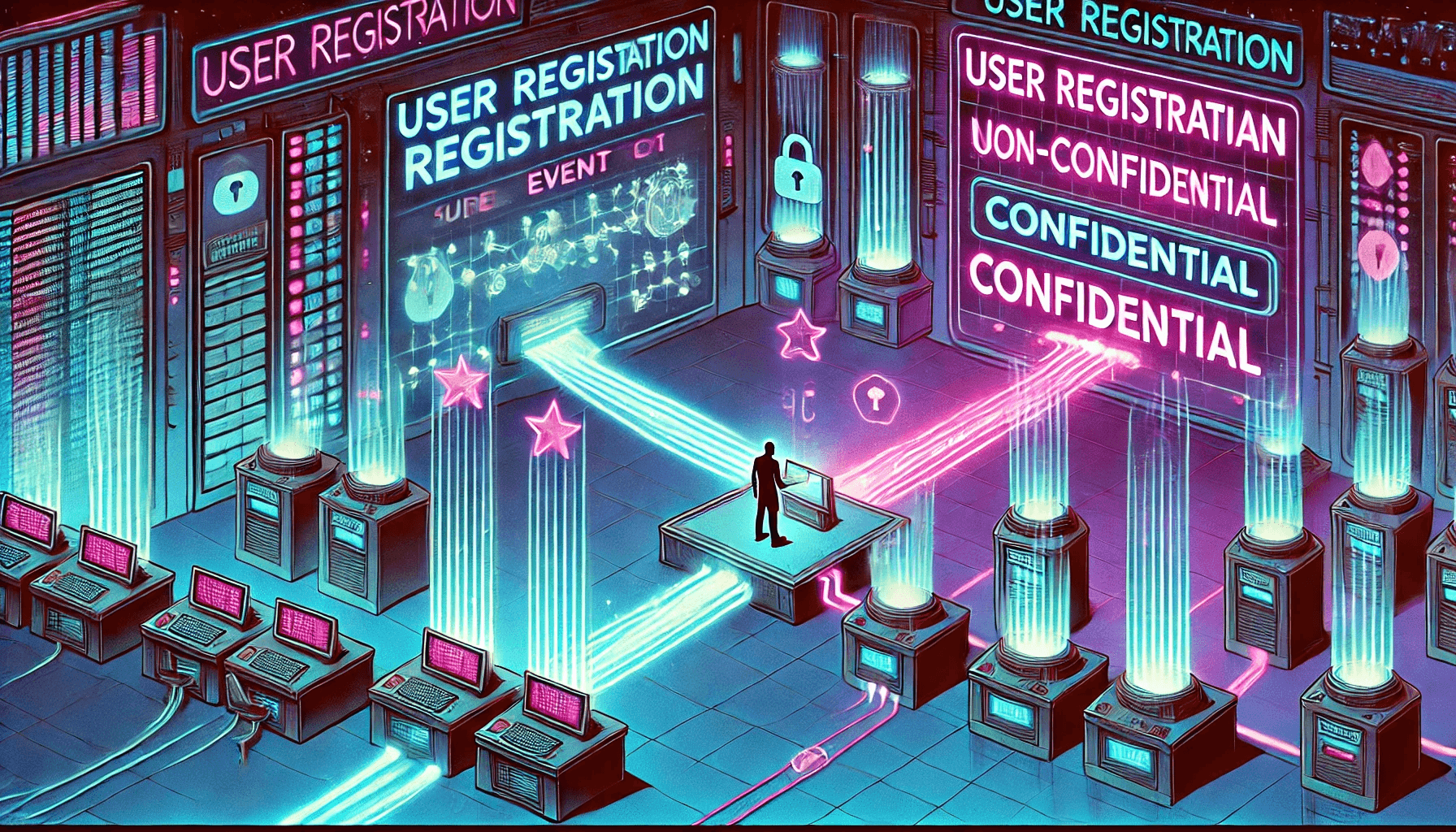Ensuring Data Security in Event-Driven Architecture
Posted on the 6th of March, 2025

Event-driven architectures (EDAs) rely on Event Gateways to route and manage events between decoupled services. While this approach unlocks massive scalability and agility, it also introduces significant security challenges. With sensitive or confidential data potentially streaming across a central hub, organisations must take extra care to safeguard this information, ensuring its integrity and compliance with regulations.
I’ll outline key strategies and best practices for securing data in event-driven architecture in this article.
Protecting confidential information in EDAs
EDA’s systems often carry personally identifiable or confidential information within the event payloads. I’m talking about user information, financial records, health information, and more.
In contrast to a point-to-point model, EDA acts as a broadcast model, which means data can be broadcast to many services. From a security standpoint, this is not good. This means that the chances of a data leak or compromise increase exponentially. As the complexity of EDA grows, this concern only continues to get worse.
Now that the problem is laid out let’s review some widely used strategies to protect data.
Data Minimization & Segregation
The basic rule here is simple: only include the necessary data in each event. It seems simple, right? However, it’s common for teams to add to current events constantly, neglecting the exercise of architecturing the events such that personal data is segregated from the ones where consumers need them.
Let’s go with an example: Imagine an event triggered whenever a user registers. You might have two services interested in this action, but with different needs:
- Analytics Service: Only the number of daily registrations must be counted.
- Account Service: Needs to create an account and requires some confidential information.
While the second service might need sensitive data (and even then, only the specifics it truly requires), the first service doesn’t need any. If you were to send a single event containing all the information to both services, you’d risk exposing confidential data unnecessarily. A better solution is to split the action into two separate events:
- One event with essential information for the analytics service.
- Another event was tagged as containing classified information for the account service.
Keeping personal/confidential data segregated gives more options to apply security and privacy rules and makes them more manageable.
Pseudonymization/Anonymization
When possible, replace direct personal identifiers with tokens or references. For example, use a user ID or hash instead of a raw name or email. While it’s not 100% reliable, one thing is for sure: If the event is intercepted, it doesn’t directly reveal the person’s identity, helping to mitigate privacy risks under regulations like GDPR.
Let’s build on the previous example. Now, the user registration action triggers two events:
- One event is just for counting purposes, which is anonymous.
- Another event with classified data, but instead of raw identifiers, it uses hashes or user IDs.
If a third, unauthorized consumer intercepts the event, they won’t immediately know the actual information. Meanwhile, the authorized consumer knows how to decrypt or map these identifiers back to the raw data.
Using pseudonymization significantly reduces the impact of a potential data breach.

Encryption and Access Controls
Encryption and Access Controls are two dedicated articles, but I’ll do my best to make them simple; they are fundamental to securing your EDA. Even as events travel through numerous services or are stored temporarily, they ensure that the data remains confidential and only reachable by the proper entities. There are several ways to think about encryption:
- Encrypt in Transit: Use protocols like TLS to encrypt all event traffic and prevent eavesdropping. For example, in Azure Event Grid, all communication should occur over HTTPS or secure AMQP.
- End-to-End Encryption: The producer encrypts the payload with a public key, and only the final consumer can decrypt it with a private key. This approach ensures that even intermediate systems can’t access the raw data.
- Encryption At Rest: Protect data stored on disks or databases using encryption keys managed by services like Azure Key Vault.
- Access Control & Authentication: Authenticate services using tokens or certificates and enforce Role-Based Access Control (RBAC) to restrict access based on roles.
- Key Management: Use a key management solution to store and rotate keys securely. Never hardcode keys in your codebase.
Implementing robust encryption and access controls ensures that even if bad actors tap into the event stream or breach a component, they cannot read sensitive data or perform unauthorized actions.
Integrity and validation
Always treat the events as untrusted input! This means implementing event validation, such as schema checks, digital signatures, checksums, and time-based validation, to ensure no one has tampered with the message.
Let me lay down some examples.
Suppose the Account Creation Event is supposed to include:
- userId(UUID)
- email (string, valid email format)
- phone (string, optional)
- timestamp (ISO 8601 format)
If a compromised service or a bug sends an event with missing fields or incorrect data types (e.g., a string instead of a UUID for userId), it could cause errors or security vulnerabilities.
So, before the consumer successfully processes the event, it performs a schema validation:
- A JSON schema contract defines the event's expected structure and data types.
- If the event fails validation, it's rejected and logged for further investigation.
In this example, schema validation acts as a gatekeeper, ensuring that only well-formed events proceed for processing.
Now, with the same example, let's say an attacker manages to intercept and modify the event by changing the email. To prevent this situation, let's see how the digital signatures work:
- When generating the event, the producer creates a hash of the event payload using a secure hashing algorithm.
- Then, the producer signs this hash with its private key to create the digital signature.
- Attach the digital signature to the event before sending it.
When the consumer receives the event, it will:
- Retrieve the producer's public key (it can be stored in Azure Key Vault, for example).
- It recomputes the hash of the event payload and verifies the digital signature using the public key. If the signature is valid, it confirms and processes the event. If not, it rejects it and logs a security alert for possible tampering.
Digital signatures ensure that events are authentic and untampered, preventing attackers from modifying events in transit or impersonating trusted services.
Audit trails
Always keep a secure log of event flows and accesses. Audit trails are essential for maintaining security, supporting forensic analysis, and ensuring compliance with regulations like GDPR and HIPAA. An audit trail provides a secure log of who accessed or altered data, what actions were taken, and when they occurred. By integrating with monitoring and logging tools, organizations can track the flow of events and detect suspicious activities.
Let's build on the previous example.
In a healthcare platform that manages patient data, a user registration triggers an Account Creation Event containing sensitive information (like email, phone number, and possibly health-related metadata). Since the data is subject to HIPAA regulations:
- The registration service publishes the event.
- An audit log entry is created every time a service subscribes to or consumes this event.
Audit Log Entry Example:
1{2 "eventId": "abc123",3 "eventType": "AccountCreation",4 "producer": "registration-service",5 "consumer": "account-service",6 "timestamp": "2025-03-04T10:15:30Z",7 "action": "READ",8 "userId": "user123",9 "location": "East US",10 "status": "SUCCESS"11}
The audit log records who produced and consumed the event, timestamps, and action types. This provides a detailed history that satisfies compliance requirements for HIPAA (which demands that access to Protected Health Information (PHI) be logged) and GDPR (which requires data processing activities to be auditable).
In Conclusion
In my view, these are the basic strategies to follow. There are others, such as limiting the number of exposed endpoints, secure deployment practices, and implementing disaster recovery and business continuity, but at least these ones can provide a good starting point.
By carefully designing what goes into each event and how it's protected, you can prevent data leaks while reaping the benefits of an event-driven architecture. To simplify, treat events like postcards travelling through the postal system—don't write secrets in plain text and seal them whenever you can.
We at Qala are building an Event Gateway called Q-Flow—a cutting-edge solution designed to meet the challenges of real-time scalability head-on. If you're interested in learning more, check out Q-Flow here or feel free to sign up for free. Let’s take your system to the next level together.

